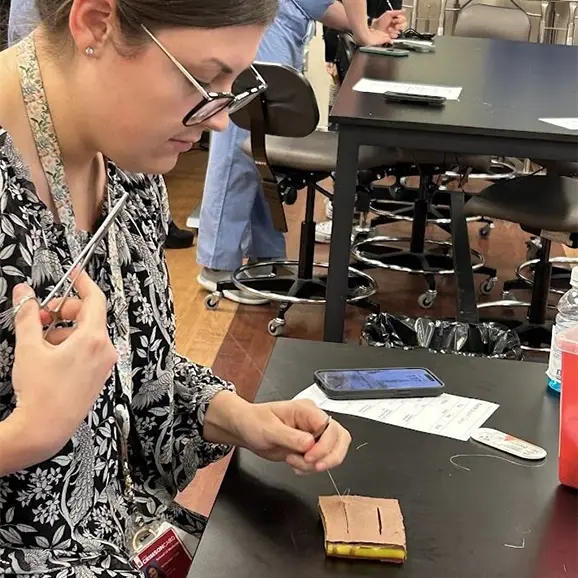At the IU School of Medicine Surgical Skills Lab, medical students practice surgical skills such as suturing, laparoscopic procedures, vascular surgery, cadaver dissections, and more. Since most affordable, commercially available suture pads do not have textured skin or variation in tissue texture, aren’t very durable, and only come in lighter skin tones — the Surgical Skills Lab team requested that the Ruth Lilly Medical Library Makerspace staff create custom suture pads that would better suit the needs of the IU School of Medicine students. After several iterations, tests, and feedback, the Surgical Skills team decided on a design and ordered the supplies and the RLML Makerspace staff created 50 suture pads for the Surgical Skills Lab to assist in training medical students.
In order to create the suture pads, the Makerspace staff first 3D modeled a mold for the suture pads and 3D printed it in the Makerspace on their Prusa i3 MK3S 3D printer. They then adhered a panel of faux leather fabric onto the base of the mold to simulate the texture of skin. A piece of power mesh fabric was cut to size and placed in the mold between the base and the walls. A Makerspace staff member then mixed a two-part silicone that is close to the elasticity of skin, along with a silicone pigment, since this particular type of silicone naturally cures to a translucent white color. For this batch of 50 suture pads, the team created 25 suture pads with a lighter skin tone and 25 with a darker skin tone - however, pigments can be mixed to create a vast spectrum of skin tones when creating a custom suture pad in the Makerspace. The first layer then took roughly 4 hours to fully cure. Once the first layer had cured, the second layer of gel-like silicone was mixed to simulate the texture of fat and incorporated with a yellow pigment. The gel-like silicone took about 2 hours to fully cure. After the fat layer had cured, the final muscle layer was mixed with the same type of silicone that was used for the first layer but colored with a dark red pigment – poured, and left to cure for another 4 hours. Once all three layers had been poured and fully cured, the mold came apart to remove the suture pad, and excess power mesh was cut from the sides of the suture pad.
The custom suture pads are available for students to use in the Surgical Skills Lab located in the VanNuys Medical Science Building on the IU Indianapolis campus. The designs for the suture pads could not have been completed without the expertise and feedback from Surgery Education Fellows, Dr. Madeline Krusing, Dr. Payton Miller, and Dr. Maya Hunt, who were instrumental in the Surgical Skills Team’s decision between different suture pad types for feel and fidelity.
If students would like to create their own suture pad, they can do so by visiting the Makerspace during their open hours, Monday-Friday: 10am-4pm.
IU School of Medicine students, faculty, and staff can also reserve time in the Makerspace by filling out the Makerspace request form at https://library.mednet.iu.edu/makerspace-reservation-form/ or email rlmltech@iu.edu.


